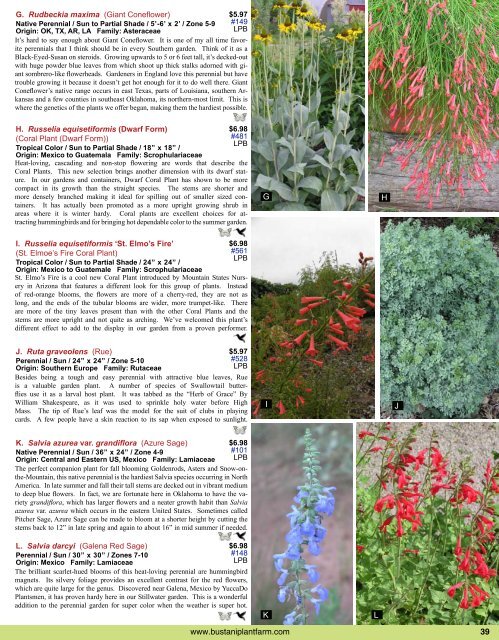Download Catalog - Bustani Plant Farm
Download Catalog - Bustani Plant Farm
Download Catalog - Bustani Plant Farm
Create successful ePaper yourself
Turn your PDF publications into a flip-book with our unique Google optimized e-Paper software.
G. Rudbeckia maxima (Giant Coneflower)<br />
Native Perennial / Sun to Partial Shade / 5’-6’ x 2’ / Zone 5-9<br />
Origin: OK, TX, AR, LA Family: Asteraceae<br />
It’s hard to say enough about Giant Coneflower. It is one of my all time favorite<br />
perennials that I think should be in every Southern garden. Think of it as a<br />
Black-Eyed-Susan on steroids. Growing upwards to 5 or 6 feet tall, it’s decked-out<br />
with huge powder blue leaves from which shoot up thick stalks adorned with giant<br />
sombrero-like flowerheads. Gardeners in England love this perennial but have<br />
trouble growing it because it doesn’t get hot enough for it to do well there. Giant<br />
Coneflower’s native range occurs in east Texas, parts of Louisiana, southern Arkansas<br />
and a few counties in southeast Oklahoma, its northern-most limit. This is<br />
where the genetics of the plants we offer began, making them the hardiest possible.<br />
H. Russelia equisetiformis (Dwarf Form)<br />
(Coral <strong>Plant</strong> (Dwarf Form))<br />
Tropical Color / Sun to Partial Shade / 18” x 18” /<br />
Origin: Mexico to Guatemala Family: Scrophulariaceae<br />
$5.97<br />
#149<br />
LPB<br />
Heat-loving, cascading and non-stop flowering are words that describe the<br />
Coral <strong>Plant</strong>s. This new selection brings another dimension with its dwarf stature.<br />
In our gardens and containers, Dwarf Coral <strong>Plant</strong> has shown to be more<br />
compact in its growth than the straight species. The stems are shorter and<br />
more densely branched making it ideal for spilling out of smaller sized containers.<br />
It has actually been promoted as a more upright growing shrub in<br />
areas where it is winter hardy. Coral plants are excellent choices for attracting<br />
hummingbirds and for bringing hot dependable color to the summer garden.<br />
I. Russelia equisetiformis ‘St. Elmo’s Fire’<br />
(St. Elmoe’s Fire Coral <strong>Plant</strong>)<br />
Tropical Color / Sun to Partial Shade / 24” x 24” /<br />
Origin: Mexico to Guatemale Family: Scrophulariaceae<br />
$6.98<br />
#481<br />
LPB<br />
St. Elmo’s Fire is a cool new Coral <strong>Plant</strong> introduced by Mountain States Nursery<br />
in Arizona that features a different look for this group of plants. Instead<br />
of red-orange blooms, the flowers are more of a cherry-red, they are not as<br />
long, and the ends of the tubular blooms are wider, more trumpet-like. There<br />
are more of the tiny leaves present than with the other Coral <strong>Plant</strong>s and the<br />
stems are more upright and not quite as arching. We’ve welcomed this plant’s<br />
different effect to add to the display in our garden from a proven performer.<br />
J. Ruta graveolens (Rue)<br />
Perennial / Sun / 24” x 24” / Zone 5-10<br />
Origin: Southern Europe Family: Rutaceae<br />
$6.98<br />
#561<br />
LPB<br />
Besides being a tough and easy perennial with attractive blue leaves, Rue<br />
is a valuable garden plant. A number of species of Swallowtail butterflies<br />
use it as a larval host plant. It was tabbed as the “Herb of Grace” By<br />
William Shakespeare, as it was used to sprinkle holy water before High<br />
Mass. The tip of Rue’s leaf was the model for the suit of clubs in playing<br />
cards. A few people have a skin reaction to its sap when exposed to sunlight.<br />
K. Salvia azurea var. grandiflora (Azure Sage)<br />
Native Perennial / Sun / 36” x 24” / Zone 4-9<br />
Origin: Central and Eastern US, Mexico Family: Lamiaceae<br />
$5.97<br />
#528<br />
LPB<br />
The perfect companion plant for fall blooming Goldenrods, Asters and Snow-onthe-Mountain,<br />
this native perennial is the hardiest Salvia species occurring in North<br />
America. In late summer and fall their tall stems are decked out in vibrant medium<br />
to deep blue flowers. In fact, we are fortunate here in Oklahoma to have the variety<br />
grandiflora, which has larger flowers and a neater growth habit than Salvia<br />
azurea var. azurea which occurs in the eastern United States. Sometimes called<br />
Pitcher Sage, Azure Sage can be made to bloom at a shorter height by cutting the<br />
stems back to 12” in late spring and again to about 16” in mid summer if needed.<br />
L. Salvia darcyi (Galena Red Sage)<br />
Perennial / Sun / 30” x 30” / Zones 7-10<br />
Origin: Mexico Family: Lamiaceae<br />
$6.98<br />
#101<br />
LPB<br />
$6.98<br />
#148<br />
LPB<br />
The brilliant scarlet-hued blooms of this heat-loving perennial are hummingbird<br />
magnets. Its silvery foliage provides an excellent contrast for the red flowers,<br />
which are quite large for the genus. Discovered near Galena, Mexico by YuccaDo<br />
<strong>Plant</strong>smen, it has proven hardy here in our Stillwater garden. This is a wonderful<br />
addition to the perennial garden for super color when the weather is super hot.<br />
G<br />
I<br />
K<br />
www.bustaniplantfarm.com 39<br />
L<br />
H<br />
J


